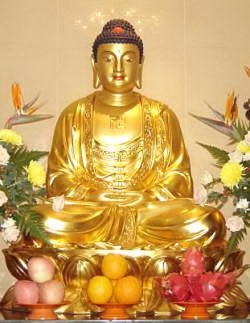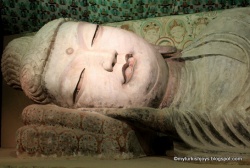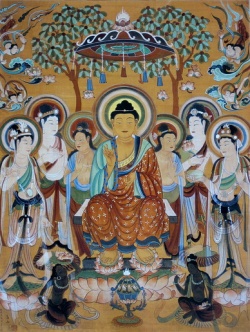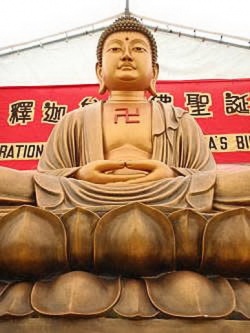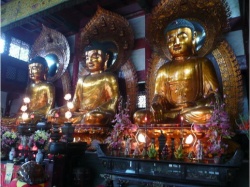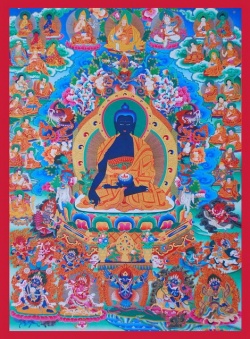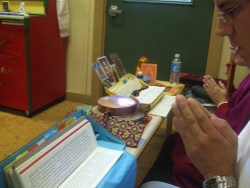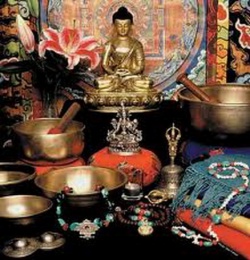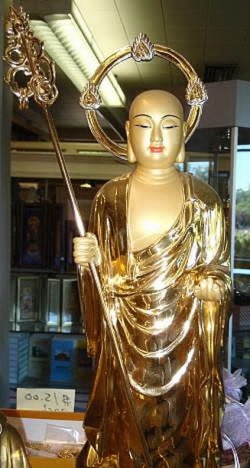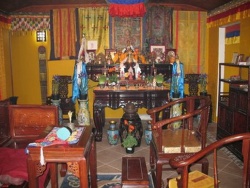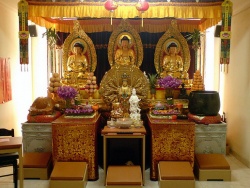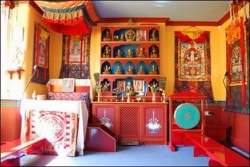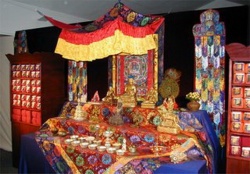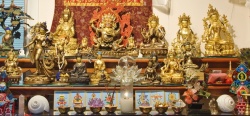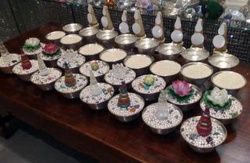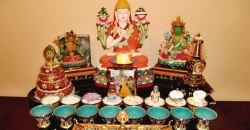Buddhist images and image worship
THE temples of the Buddhists, like other Chinese structures, usually look south. Their architecture also is similar. Temples cut in rock, like those of the same religion in India and Java, are not found. In natural caves, however, and on hill sides images are sometimes cut from the stone.
Temples consist of several halls and chapels called by a common name, tien.
In the "entering hall" (sï-i‘ien wang-tien), two colossal wooden statues meet the eye on each side. These are the Mahârâjas, or "Four great kings of Devas," or Sï-ta-t‘ien-wang.
The Sanscrit names are explained: "Vaishravana" (Pi-sha-men), "He who has heard much;" "Dhritarashtra" (T‘i-to-lo-to), "Protector of kingdoms;" "Virudhaka" (Pi-leu-le-cha), "Increased grandeur;" and Virupaksha (Pi-lieu-pa-cha), "Large eyes." They are called in Chinese To-wen,Ch‘ï-kwo, Tseng-chang, and Kwang-mu.
They govern the continents lying in the direction of the four cardinal points from Mount Sumeru, the supposed centre of the world.
In the Kin-kwang-ming-king, they are described as actively interfering in the affairs of the world. When kings and nations neglect the law of Buddha, they withdraw their protection. They bestow all kinds of happiness on those that honour the San-pau (Three treasures), viz., Buddha, the Law, and the Priesthood.
Properly they are all warlike, but as seen in temples they are dressed in different modes. He of the South holds a sword. He has a black countenance and ferocious expression. The others have blue, red, and white faces. One holds in his hands a "guitar" (p‘i-pa), at the sound of which all the world begins to listen, or, as some say, the camps of his enemies take fire. Another has an umbrella in his hand, at the elevation of which a violent storm of thunder and rain commences; or, according to others, universal darkness ensues. Another holds in his hand a snake, or some other animal hostile to man, but by his power made submissive and instrumental to the wishes of its conqueror.
Between them and the south wall are sometimes placed two figures in military attire and with fierce countenances, called Heng-Ho-er-tsiang, "the two generals Heng and Ho."
In the same building, opposite the door, is usually an image of "Maitreya Buddha" (Mi-li Fo), or the Buddha to come. The Sanscrit name, Maitreya, means the "Merciful one." He is always represented as very stout, with the breast and upper abdomen exposed to view. His face has a laughing expression. After three thousand years he will appear in the world and open a new era.
An image of Kwan-fu-tsï the Chinese deified hero, in his capacity as protector of the Buddhist religion, is also sometimes placed in this hall on one side of the north door. Behind Maitreya is the image of Wei-to, a Deva who is stiled Hu-fa-wei-to, or the "Deva who protects the Buddhist religion." He is represented clad in complete armour and holds a sceptre-shaped weapon of assault usually resting on the ground. He is general under the Four kings.
The shrine in which these two idols are placed forms a screen to a door behind, which opens into the court of the "Great hall" called Ta-hiung-pau-tien. This is appropriated to the images of Shakyamuni Buddha and a select number of his disciples. He is represented in an attitude of contemplation, sitting on a lotus-leaf däis; Ananda, a young-looking figure, and Kashiapa, an old man, are placed on his right and left.
On the east and west sides of the hall are arranged eighteen figures of "Arhans" (Lo-hans). They are represented as possessing various kinds of supernatural power, symbolised in some instances by wild animals crouching submissively beside them. They listen to Buddha, some with thoughtfulness, some with pleasure. Along the north wall are often to be seen the images of Jan-teng, an ancient Buddha, and of six Bodhisattwas and disciples of Shakyamuni, viz., Kwan-yin, P‘u-hien, Shï-chï, Wen-shu, Shariputra, and Maudgalyayana. This is the arrangement at the Kwang-fu-sï, the principal monastery in Shanghai.
Wen-shu and P‘u-hien often take the right and left of the central Buddha. Behind the three central images, and looking northwards, is usually placed an image of Kwan-yin with rock, cloud, and ocean scenery rudely carved in wood and gaudily painted. This Bodhisattwa, with Wen-shu and P‘u-hien, is sometimes placed in front, as at Lung-hwa, near Shanghai, Kwan-yin occupying the centre, immediately behind Shakyamuni, who then sits alone on his däis in the midst of the hall. This hall, the highest and largest building in the whole monastery, takes its name from one of Buddha's titles, Ta-hiung, or "Great hero"—in Sanscrit, Virah—with the addition of the word pau, "precious."
The image of Kwan-yin has several forms corresponding to the various metamorphoses which he or she assumes. Two of the commonest are those of the Northern and Southern sea. In the large cloud-and-water picture in alto-relievo, of which he so often forms the principal figure, several smaller personages are added to lend variety to the scene. The Four kings of Devas are occasionally employed for this purpose, and still more frequently a female figure, Lung-nü, "Daughter of the Dragon king," and a youth called Shan-ts‘ai, who form interlocutors in some of the Sutras.
Another metamorphosis of Kwan-yin is represented in a female figure, holding in her arms a child. It is in reference to this image that a parallel has often been instituted between Kwan-yin and the Virgin Mary. A stranger who did not take notice of minute peculiarities in dress, would very naturally have the idea of similarity presented to him, and mistake the child which the goddess presents to mothers praying for posterity, for the infant Saviour.
It is in part from such resemblances that Hue has adopted the hypothesis that the modern form of Buddhism in Tibet arose from a mixture of [[Wikipedia:Christianity|Christianity]] with that religion. Sometimes Kwan-yin appears with a thousand hands, symbolising his desire to save all mankind.
The interval between the hall of the Four great kings of the Devas, and that of Shakyamuni, is occasionally occupied by another hall. Kwan-yin of the Southern sea may be seen here pictured with his usual attendants. Behind, looking northwards, is often found a scene in honour of Ti-tsang Bodhisattwa. He is surrounded with cloud and rock carving, on the abutments of which are seen the ten kings of hell. They all listen to the instructions of this Bodhisattwa, who seeks to save mankind from the punishments over the infliction of which they preside.
The Hindoo god "Yama" (Yen-to-wang) is the fifth of them. Sometimes in this intermediate space there is a structure called the hall of the Lo-hans, where are found on the east and west walls, small carved figures of the five hundred Arhans of Buddhist legends. They are placed on the protuberances of a rough alto-relievo scene such as those above described. In other instances this representation of the five hundred Arhans is placed over the more powerful and better known eighteen Arhans in the hall of Shakyamuni.
In the central hall, representatives of all the four ranks above the range of the metempsychosis are found, as will be seen from the preceding details. Disciples of the lower ranks, who are, however, delivered from the world of life and death, and are called sheng-wen, "listeners," are represented in Ananda and Kashiapa; the one holding a written scroll emblematic of his great work, the compilation of the Sutras; the other resting on a staff, the symbol of his office, as successor of Buddha in the patriarchate.
They are bareheaded and close shaved. The "Arhans" (A-lo-han), eighteen in number, speak for themselves as to the extraordinary power, knowledge, and gratification which they have gained through listening to the teaching of Buddha, by their attitudes as conquerors of evil, and defenders of good, and by the expression of intelligence and pleasure which the artist has attempted to depict on their countenances. The rank above this, that of Bodhisattwa, uniting great knowledge and power with strong desire to save those beings who are still involved in the metempsychosis, is represented in Wen-shu and P‘u-hien wearing crowns gilt and ornamented in the lotus-leaf shape.
To the highest rank of all in wisdom and power, that of Buddha, belong Shakyamuni, and his instructor in a former life, Jan-teng. They have short curly hair formed of shells, and painted a dark blue. Devas sometimes appear there, e.g., "Brahma" (Fan-t‘ien) and "Shakra" (Ti-shih), who in some temples make two of six auditors of Buddha, the others being Ananda and Kashiapa, P‘u-hien and Wenshu.
As the principal hall is appropriated to the four highest classes of beings recognised by Buddhism, so the hall of the Four Diamond kings, or kings of the Devas, contains the images of those beings still involved in the wheel of the metempsychosis, so far as they are considered by the Buddhists as proper to be worshipped. Wei-to and the Four kings with their attendants all belong to the class of Devas or inhabitants of heaven.
The presence of Maitreya there may be accounted for by the fact, that he as the predicted successor of Shakyamuni in the office of Buddha, now resides in the Tushita paradise, from which at the appointed time he will descend to the earth, to assume the duties assigned him. He is not yet therefore exempt from the metempsychosis.
In the monasteries of Ceylon, a small temple termed Dewâla is placed before the chief building, and dedicated to the worship of the Devas (vide Hardy's Eastern Monachism). Thus in both cases, the visitor arrives first at the hall where the metempsychosis still prevails, and afterwards passes on to the abode of the Buddhas and Bodhisattwas.
Looking at the arrangements of these two parts of a Buddhist temple from another point of view, the large central hall already described is intended to symbolise Buddha giving his instructions to an assembly of disciples, while the leading idea of the entering hall is the representation of the powerful protection by celestial beings enjoyed by the Buddhist religion and its professors. In some large temples, Wei-to, and a king of the Devas, holding a pagoda in his hand, stand with the usual figures on the right and left of Shakyamuni.
Twenty Devas, ten on each side, are also sometimes placed at the south end of the two rows of Arhans that line the eastern and western walls. This accords with the descriptions given in the Sutras of the audience gathered round Buddha on remarkable occasions, when the inhabitants of the various celestial mansions hold a conspicuous position among the crowd of his disciples.
The carrying out of this thought is doubtless the prevailing aim in the choice of personages, attitudes, dress, and positions, and all is in agreement with the "Developed" Sutras or those of the Mahayana class used by the Northern Buddhists. Exceptions to this rule occur. For example, figures illustrating the thirty-two points of personal beauty belonging to Buddha are in some temples placed where the Arhans are usually found.
So also, in large temples, instead of the two disciples on each side of Julai, are two other figures of Buddha, representing the future and the past, as the central one does the present. The three images are much alike, and each of them wears the close-fitting skull-cap of painted shells which is always appropriated to Buddha.
Facts of this latter class point to another aim as influencing the arrangement of the figures, that of presenting to the mind of the visitor a picture of the conception of Buddha, in its most expanded form, each image exhibiting a distinct feature of the ideal whole to the contemplation of the worshipper. This principle of arrangement is, however, followed much less frequently than the former.
The idea of celestial protection as prevailing in the arrangement of the entering hall, has already been illustrated in the description of the Four kings and of Wei-to. It may be further observed, that the beings called K‘ia-lan (Ga-lam) or protectors of the "monasteries" (sangarama), viz., Kwan-ti, the god of war, and others, are placed here in vacant spaces, as in a suitable spot.
The other "chapels" (tien) or halls are erected on the side of or behind the central structure. They are appropriated to Yo-shï Fo, O-mi-to Fo, Ti-tsang p‘u-sa, and the ten kings of hell. Other names occur, such as the hall of the thousand Buddhas, &c., but these are the most common.
In some instances, as for example in the Kwan-yin-tien, there are two images, one light enough to be carried in a sedan chair for processions, another larger for daily worship. Kwan-yin is sometimes represented in eight metamorphoses, assumed for the purpose of saving men from eight kinds of suffering. Shipwrecked sailors, in one part of the carving, are seen reaching the shore. In another some traveller escapes from a wild beast. The deliverer Kwan-yin stands by. In a scene of this kind, the image of this divinity is thus repeated eight times, besides the larger one in the centre.
The whole is called Pa-nan Kwan-yin, "the Kwan-yin of eight kinds of suffering."
Kwan-yin is also occasionally found in a subordinate position, as one of the two supporters of "Amitabha Buddha" (O-mi-to Fo), Shï-chï being the other. They are called together the three sages of the west. O-mi-to is also called Tsie-yin Fe, or the "Buddha who receives suffering mortals to the rest of the Western paradise over which he presides, and to which he guides them."
The usual right and left supporters of Yo-shï Fo, the Buddha of the East, are Yo-tsang p‘u-sa and Yo-wang p‘u-sa. These preside over medicine, but the jurisdiction of the Buddha himself is not limited to healing; it includes all kinds of calamity. He is sometimes represented like Shakyamuni with three images, denoting the past, present, and future.
Ti-tsang is often attended by the ten kings of hell, from whose punishments he seeks to save mankind. All of them, except Yama, have Chinese names. Some of them point to particular localities, as Pien-ch’eng, or the city of K‘ai-feng fu. T‘ai-shan is a mountain of Shan-tung. Others refer to attributes, as p‘ing-teng, "even," chuen-lun, the "turner of the wheel (of doctrine)." Criminals receiving punishments and attendants are also represented by small earthen or wooden figures. The ten kings all stand when in the presence of Ti-tsang p‘u-sa; but if Tung-ngo-ti-kiün, a Tauist divinity, presides, they may sit, he being little superior to them in rank. Most of the names of these ten kings are of Chinese origin and not many centuries old.
Ti-tsang is represented by the priests as the son of a king of Siam. He has a full round countenance of mild aspect, with a lotus-leaf crown, the usual head furniture of a Bodhisattwa. The figures on his right and left are sometimes Muh-kien-lien and P‘ang-kü-shï, disciples of Shakyamuni Buddha. Elsewhere Min-kung and Min-tsi take this position. The former was a Chinese who gave the land at Kieu-hwa, the hill some miles west of Nanking, on which is erected a large monastery in honour of Ti-tsang. Min-tsi is his son. Two other disciples, who act as "servants" of the Bodhisattwa (shï-che), are also represented by two other smaller figures.
The idols called P‘u-sa sit when in their own shrines, but if in the presence of Buddha they stand.
Taoist idols are numerously employed in the Buddhist temples. Kwan-ti, Lung-wang, and Hwa-kwang have been formally adopted by the sect as protecting divinities. Several of a medical character are also extensively made use of, obviously to attract those who in time of sickness seek aid from supernatural sources. Diseases of the eye, ulcers, the small-pox, and bodily ailments in general are assigned to the care of various heavenly beings, and the sick in large numbers seek their assistance.
"He who presides over riches," Ts‘ai-shen, whose popularity is unrivalled among all the Chinese divinities, has also a shrine bestowed on him. There are also many others, such as San-kwan, Yü-ti, &c., which, as properly belonging to Taoism, will not be described here.
Celebrated Chinese Buddhists have also images where the arrangements of a temple are complete. That of "Bodhidharma" (Ta-mo ch‘u-shï) is frequently met with in temples where priests of the tsung-men reside, as also that of the founder of the monastery.
According to the explanations of the philosophic Buddhists, the principle of arrangement and the use of idols tit all must be viewed as symbolical, as already remarked. When the worshipper enters he is met with the idea of "protection" from celestial beings. As he advances into the presence of Buddha, he sees in his image "intelligence," the fruit of long and thoughtful contemplation. In the Bodhisattwas are exhibited "knowledge and mercy" combined.
In the Arhans he sees those who have become "venerable" by years, wisdom, and a long course of asceticism. In the sheng-wen, the bareheaded "disciple," he sees the first step in progress towards the Nirvâna, the introduction to the other three. When he bows before these images, and makes his offering of incense, candles, and gilt paper, this also is a symbol. It only means the reverence with which he receives the instructions of Buddhism.
The common people, however, as happens in Christian countries where the worship of images prevails, see in each idol a powerful divinity, and losing sight of the moral and intellectual objects of the system, pray to be freed from sickness, poverty, childlessness, an early death, and other dreaded evils. Such a faith in the objects of their idolatry is of course encouraged to the utmost by the priests, whose prosperity depends upon the number of the worshippers.
In April 1858, I visited at Galle, in Ceylon, two Buddhist temples. The image of Buddha is remarkably like what it is in China. The skull-cap, the posture, and the form of the body are the same. It is made of mud and gilt in the same manner. Three Buddhas were represented, and they were all called Godam and Shakyamuni. The disciples were Mogallana, Shariputra, Ra-hula, Ananda, and Kashiapa. The last two of these do not, as in China, occupy the nearest place to Buddha. Brahma and Vishnu were the kings of the Devas represented.
I noticed a pictorial representation of heaven and hell, and I know not what more, upon the four faces of a square screen that completely surrounded Buddha's image. On the inside face of the screen were images of Vishnu and Brahma, with other Devas. A Garuda attended Vishnu.
Beside the smaller temple was a stupa or "tomb" of Buddha. It was a handsome circular mausoleum, apparently of stone, twelve or fourteen feet in height. In China this would be a pagoda.
In the series of painted tableaux, hell was on the left, and heaven on the right. Heaven was also on the back of the screen.
Beside each temple lives a priest in a yellow kasha, with his pupils, whom he teaches to read. Fresh flowers of the strongest odours are constantly placed in abundance on the altar before Buddha. There were also oil lamps, which were not lit. Both temples were on an eminence in secluded spots and encircled by trees.
A few cottages of the Singhalese were near. They looked wretchedly poor.
A friend with me from Siam, Mr. Alabaster, informed me that the temples in Ceylon are entirely different in appearance from what they are in Siam. The following is the arrangement of the images in a temple at the Western hills near Peking. In the centre, Shakyamuni; on his right, Kwan-yin; on his left, Shï-chï. In front there are three large fans (a cylindrical cloth is so called), embroidered with inscriptions, hanging from the roof-beams. The däis on which are the three images is supported by lions, elephants, and griffins. The horse-shoe shaped aureole which encircles Buddha's head is carved with winged monsters and warriors.
Paper rubbings of the sixteen Lohans from Hang-cheu hang on the side walls. These are celebrated as having been carved in the T‘ang dynasty. They were made eighteen at a later period. The sixteen were Hindoo, and there are Sanscrit characters on the fifth in order. The addition of two is due to Chinese love of change, originating with we do not know whom.
If the observer is reminded in the carved entablatures of stone pagodas of old date, that there is a resemblance to Greek and Roman sculpture, let him meditate on the idea that Alexander's conquest of Persia and invasion of India was a signal for a host of new thoughts to originate in the countries conquered. Stone sculpture may have come in this way into India, and elevated the ruder art there prevailing.
In Peking and its neighbourhood metal images are not uncommon. Shakyamuni and the two favourite disciples who usually accompany him are sometimes seen made of copper or white copper, about six feet high, with hanging bands of yellow cloth suspended in front of them. To these bands small bells are attached, which ring when shaken with the wind, or when touched by the priests or by visitors coming forward to burn incense.
In North China it is also common to see pictures of Buddhist subjects painted more or less rudely on the walls of the halls where the images are seen.
One of the forms, as said already, in which the goddess of mercy is adored is as the "Kwan-yin of the eight misfortunes" which attend unprotected travellers. In painting them on walls travellers are seen, for example, on a mountain attacked by robbers, who draw their bows at their intended victims. Just at this moment the goddess and her attendant appear in the air, and save the travellers by rendering them invisible. This is accomplished by pouring a fluid from a bottle which becomes a cloud in its descent, and intervenes between the travellers and the banditti.
In the monasteries in North China are sometimes found a tooth of Buddha, or some other relic. One tooth I saw at the temple called Teu-shwai-sï was two inches and a half thick and ten by thirteen in width. Relics are kept in bottles and shown to visitors.
In the T‘ang dynasty a vast number of temples and pagodas were erected. It became the fashion then, under the influence of the superstition of feng-shui, which came into vogue in the time of that dynasty, to build pagodas for luck as well as to contain relics. The pagoda of T‘ien-ning-sï, near Peking, on the south-west, and dating from the Sui dynasty, must have been then in the old city. The Pa-li-chwang pagoda would be a feng-shui protector on the north of the ancient city. On both these pagodas, which are strongly built of stone, there are carved Buddhas and Deva kings on large entablatures. The former and older of these pagodas grows narrower as it rises.
The other is almost as wide above as below.
The Peking custom in making large images, whether they are of brass, iron, wood, or clay, is to construct them with the internal organs as complete as possible. While the smaller images are filled with Tibetan incense or cotton wool, the larger have the interior arranged according to Chinese notions of anatomy.
The heads are always empty. The chief viscera of the chest and abdomen are always represented. They are of silk or satin, and their shape is that found in drawings of the organs in native medical works. A round red piece of silk represents the heart, whose element is fire. It is the size of a dollar. It and the lungs, which are white, and divided into three lobes, are attached to a piece of wood, round which is wound a piece of yellow paper, having on it a Tibetan prayer. To the wood is attached, by silk threads of five colours, a metallic mirror called ming-king. This represents intelligence, the heart being regarded as the seat of mind. The lungs cover the heart as an umbrella or lid, as if to preserve it from injury.
In the abdomen the intestines are made of long narrow pieces of silk with cotton wool stitched along the concave border. This may represent fat or the mesentery. Embracing all, like the peritoneum, is a large piece of silk covered with prayers or charms. Inside are also to be found little bags containing the five kinds of grain, with pearls, jade, small ingots of silver, and gold of five candareens’ weight, and bits of solder of various shapes to represent silver.
The larger and older idols have, in very many cases, been rifled of these little valuables, no one knows when. Poor priests in want of money, if the fear of sacrilege is not strong in their minds, know where to get help, so that idols, in the interior of which gold and silver were once deposited, have now none. In the metallic images, the way to get to the inside is from the bottom. As they are very heavy, they have usually escaped being robbed. But the clay and wooden images are packed from a hole in the back, and are more liable to thievish depredation.
When the idols are set up there is a ceremony of consecration. The priests prostrate themselves before them, and a film of clay or some other substance is cleared away from the eyes of the idols. It is called the ceremony of opening to the light, and the day is spoken of as k’ai-kwang-jï-tsï.
The richest temple at the Western hills near Peking is that called Tan-cho-sï. It has a revenue of twelve thousand taels of silver a year. This is between three and four thousand pounds. In 1866 I arrived there one evening with some friends and slept in a guest room. At the evening service there were about forty priests performing. In addition to chanting they struck the wooden fish, clashed cymbals together, and had several other kinds of simple instruments. At the end of the service they all walked in single file round the hall twice behind the images. The reason why the three principal images in front of the great central door are placed with a space behind them is, that a procession behind may be practicable. It is also convenient to have a door there, and in front of the door an image or picture, which is, consequently, at the back of the three principal idols.
In a box given a century ago to this monastery by the emperor, and placed near the western wall of the large hall, is a snake two feet long. Beside it is a porcelain tray of fresh water. When a rap on the box is given by the attendant priest, the snake moves its tongue out about half an inch, vibrating it in token of reverence and submission. It takes nothing but water. So the priest assured us. If we are to believe him, it had been there for two thousand years. The snake is not worshipped as a divinity, but rather represents the power of Buddha in charming and taming a savage nature. It was a snake with brown body and black spots, and its head was small. The power of Buddha keeps the animal in subjection. That is the theory. If the snake goes out of the box, as it does occasionally to take an airing, it returns to it as to its home.
We also saw a structure called the Leng-yen-tan. It has eight sides, and is used as an altar to represent in its carved ornaments the scenes of the Leng-yen-king. The central figure is what is called a Pratyeka Buddha. Round it on the eight sides are carved eight representatives of Shakyamuni. Above them are crowns of flowers. Singularly enough there are placed here six Portuguese sailors, with iron cuirasses and broad-brimmed hats, in European fashion. Each of them kneels on one knee, and holds up with both hands an offering to Buddha. They are small iron figures, made in the time of the Ming dynasty, and are called Si-yang-jen. This is the name by which the Portuguese are known in China.
There is behind the Leng-yen-t‘an an altar for receiving new monks to the vows, that is, a Kiai-t‘an, consisting of two stories. On the upper story or terrace are arranged chairs for the abbot and his assessors. The abbot sits on the central chair, and six monks on each side. The neophyte kneels with his face toward the "abbot" or fang-chang, from whom he is separated by a table. The rules are read by the abbot while the neophyte kneels.
T‘an also belongs to the school of the "Vinaya" or Lü-men.
There had been a storm of rain, and we were invited by a friendly priest to go and see the foaming and dashing water near the great gate of the monastery. The bed of the stream is steep, and filled with large stones. The water coming down the mountain after a storm rushes madly over boulders and gravel to the bridge, and is shown to every visitor.
Near this spot is a small temple in honour of Pratyeka Buddha. The temple is called An-lo-yen-sheu-tang. The terrace on which is placed the image of Pratyeka Buddha is supported by four protectors of the law of Buddha. These four personages were once in a robber band of five hundred men, and they lived at that time for nothing but crime. They were subdued to virtue by the teaching of Buddha. In gratitude for the enlightenment they received, they offered to carry Buddha henceforth on their shoulders.
The Pratyeka Buddha wears the skull-cap of the ordinary Buddha. It is supposed to be the form assumed by the hair after several years of ascetic retirement in mountain solitudes.
At Pi-yün sï, a temple twelve miles west of Peking, there is a hall of five hundred Lo-hans. The building is a large square, and contains six galleries. It is entered from the north. The first figure met by the visitor is Maitreya. He faces the door. Beyond and behind him is the central north and south gallery. On each side of it, as of the other five galleries, are seated full-sized figures of Lo-hans. They are of clay and seated on a stone terrace two feet in height. To the right and left are parallel galleries. Four small courts in the centres of the four quarters of the large square give light by continuous rows of paper windows to the galleries. On a beam overhead, near the entrance, is a small figure, the five hundred and first, which was placed there as a supplementary image. The story is that this Lo-han came too late, the places were all filled, and, therefore, he was accommodated with a seat in the roof.
In another court are representations of the future state. Mountain scenery, clouds, bridges, lakes, as well as men and other living beings, are represented in clay. The five principal Bodhisattwas preside, and especially Ti-tsang. Good Buddhists are seen crossing a bridge with happy faces. Bad men are pushed by demons into a place of torture below. Various cruel punishments are represented. Everything is in carefully moulded and coloured clay. Kwan-yin is associated with Ti-tsang in presiding in the side halls. Along with the three other divinities, Wen-shu, P‘u-hien, and Ta-shï-chï, they preside with equal honour in the centre hall. On the coloured rock-work, the tortures of the wicked and the happiness of the good are mixed, to indicate the results of Buddhist teaching as imparted by the five divine instructors.
Above these courts is the chief court of the temple with Shakyamuni's hall, the residences of the priests, and the guest rooms. In the principal guest room there is a large picture hung on the wall descriptive of an ancient Chinese princess, Chau-chiün, who was demanded by the king of the Hiung-nu Tartars as an indispensable condition of peace, and was sent to Tartary accordingly. She leaped into the Black River and was drowned. In the picture she looks unhappy at the forced exile from her home and country. At some distance behind her is the Shan-yü or emperor of the Hiung-nu.
Above this hall is a very handsome marble gateway. It is flanked by large stone lions. The pillars are surmounted also by lions. The cross-beams are carved with phoenixes above and dragons below. Two large entablatures have carved scenes representing the triumph of the four virtues—hiau, "filial piety," chung, "loyalty," lien, "official purity uncorrupted by bribes," and tsie, "chastity." Certain celebrated persons are here represented. Above this is a pagoda of the shape called Kin-hang pau-tso, "Diamond throne." It is very massive and is built with blocks of marble. On the square flat summit are seven small pagodas surmounted with bronze caps. The larger ones have thirteen stories, but they are very shallow. There are various inscriptions cut in the stone, Tibetan and Chinese. The view of Peking from the summit is very fine.
In the province of Che-kiang I have seen two large stone images of Buddha cut out of mountain rock. One is at Hang-cheu, and the other at a town called Sin-chang. The second of these is the larger of the two. The road to it extends a mile and a half to the south-east of the city, and it is seventy feet high. That at Hang-cheu is not, I believe, more than forty. The Sin-chang image is more than a thousand years old, and was cut by the labour of a father, son, and grandson, requiring the chiselling of three generations. It is an image of Maitreya, the coming Buddha. Being so majestic in height, the sight of this image is very impressive. It is about the height of Nebuchadnezzar's image on the plains of Dura, and has a reflecting benevolent aspect.
The wooden image of Maitreya in Peking, at the large lamasery, Yung-ho-kung, is still higher.
The traditional height of Shakyamuni, the historical Buddha, is sixteen feet. That of Maitreya appears to be sixty. Let it be remembered that teeth of Buddha and also his footsteps in rocks are of monstrous size.
In Hiuen-tsang's travels he mentions a statue of wood at Dardu, to the north of Cashmere and the Punjab. It was a hundred feet high, and was executed by the Lo-han Madhyantika, who converted to Buddhism the king of Cashmere and all his people. By magic he raised a sculptor to the Tushita paradise to see for himself the wonderful form of Maitreya. After going up three times he executed this image.
An enormous tope, or Buddhist tower, was seen by the traveller ten li east of Peshawur, in the Punjab. It was three hundred and fifty feet round, and eight hundred feet high. Every Buddhist structure in China is dwarfish beside this. From its erection till the year A.D. 550, a period of eight hundred and forty-two years were said to have passed. This would show that in B.C. 292 Buddhism was the prevalent faith in the Punjab. Modern travellers have found it west of the city, and still remarkable for its immense size. It was built—if this statement can be accepted—in the reign of Chandragupta, with whom Seleucus concluded a treaty, and at whose court at Pataliputra, the Greek historian Megasthenes appeared as an ambassador. But the Chinese travellers ascribe it to Kanishka; and this can be believed, for it is only in the time of powerful monarchs that monuments of this size can be erected; and Kanishka was a most devoted Buddhist. He was a contemporary of Augustus and Antony, as is known by coins.
The prayers are chanted by the priests either sitting, kneeling, or standing. They consist of extracts from Sutras, or special books containing charms. The extracts are statements of doctrine, of the mercy and wisdom of Buddha, and the glory attaching to him.
The prayers are not prayers in our sense. They work a sort of magical effect. The law of a secret causation connects itself with the act of the reader of the law, or the offerer of incense, flowers, and fruits.
Music accompanies the worship. The following instruments I have noticed:—the drum, small bells, cymbals, tang-tsï, ch‘ing, wooden fish, yin-ch‘ing, and the large bell.
The drum has a clapper called ku-ch‘ui.
The cymbals are of brass. Each has a cloth holder through the centre tied inside. The "cymbal" is called kwo.
The tang-tsï is a small gong, and is held by a half cross, to which it is tied by strings. It is of brass, and is struck by a small clapper.
The ch‘ing is a flat metallic plate cut in the shape of flowers. It is supported by a wooden cylindrical box, and this again rests on a low table. It has a cloth-covered clapper.
A small kind of ch‘ing is called yin-ch‘ing. A thin iron rod strikes it to keep time for the chanters. This yin-ch‘ing is two inches long by one deep, and is fastened tightly to a long carved wooden handle.
The large bell is struck by a wooden mallet.
In the images and the worship offered to them by the Buddhist monkish community, may be found a key to the solution of the question, how Buddhism as a religion has lasted so long.
It does not need faith, or conviction, or zeal. The monk's life is a quiet one. His work is very light. Nothing is expected of him but orderly conduct, and the chanting of the instructions of Buddha, with invocations and the beating of the wooden fish. The indolent become monks. Of real religious activity there is none. There is no God to worship but Buddha, and Buddha is a teacher, an uncrowned god, in the sense in which Confucius was an uncrowned king.
The monks kneel to adore images, not to pray. When seated in a large hall, they recite together the teachings of their Shakyamuni, it is to favour contemplation and reflection. The reflex influence of the images on their minds is all-important.
Good luck is expected, not through the will of any god, but through an impersonal fate.
Yet they go beyond this, and rest their faith on the legends, with which their books are crowded, relating the powerful interference of the Buddhas and Bodhisattwas; and thus these personages become, in the religious faith of the people, virtual divinities.
If however this is so, there are no printed prayers. If O-mi-to Fo, or Shï-kia Fo, or Kwan-yin p‘u-sa, are believed in as gods by the more credulous, the worship is not altered on that account. The monks still read the traditional passages out of the books of Buddha which teach the nothingness of the universe, and seem to be so many sermons on the old text in Ecclesiastes, "Vanity of vanities, all is vanity." In the Buddhist literature, prayers with special ends in view, directly addressed to either of these personages, I do not remember ever having seen more than once or twice. There is nothing but praise and invocation in an exceedingly brief form. It is a prayerless and godless religion, if looked at from the Christian point of view.
Dr Anthony Ng Chiew Kiat
